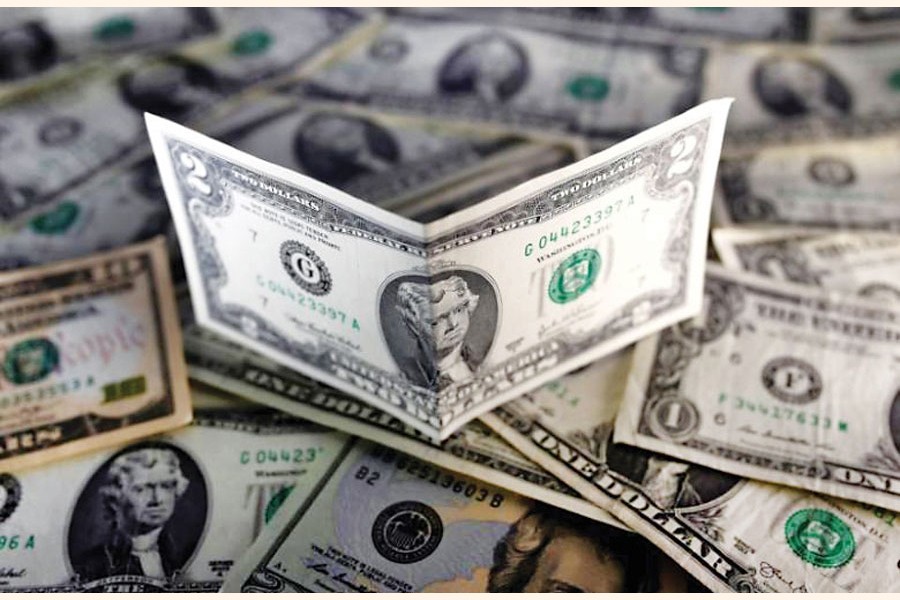When Bangladesh Bank (BB) announced its Monetary Policy for FY21, US Dollar Index indicated that the dollar declined 6.5 per cent year-to-date in value relative to a basket of six currencies. However, as economic growth has lost its lustre in developed economies owing to COVID19 pandemic, there has been a buzz around the dollar's persistent weakness for near future. Since Bangladesh holds a record USD 40.0 billion in reserve, and is expected to experience even higher reserve for at least FY21, it begs questions regarding the economic and policy implications of weak US dollar in the context of Bangladesh.
To start, it is imperative to explore why US dollar has been weakening lately, and whether the trend would sustain in near future. Currently, the US is experiencing twin deficits: current account deficit and large budget deficit. In 2019, current account deficit stood at USD 498.4bn according to US Department of Commerce, while budget deficit stood at USD 984.4bn in 2019 fiscal according to Congressional Budget Office of USA (CBO). As a result, in order to meet both deficits, US Federal Reserve (Fed) leverages on US dollar's "reserve currency" status, and prints more dollars against the US treasury bonds. However, without matching growth in real output or raising substantial taxes, the increased flow of money supply eventually leads to lowering US dollar value relative to other currencies. USA also has a USD 25.0 trillion (tn) of national debt problem, and the pandemic is expected to push the deficit to USD 3.3tn based on CBO's projection. In addition, using subsidies and aid packages, USA had limited the fallout from US-China economic cold war for now, however such protection cannot be sustained indefinitely either. On top of that, if the new administration plans to spend big to spur economic recovery at the expense of deficit, the supply of US dollars would increase even further.
From monetary side, US Fed has kept U.S. interest rates at near-zero in order to preserve liquidity in the economy, and provide the government with necessary deficit financing at low cost. Since US Fed follows policy rate model to signal its monetary policy stance, near-zero rates have narrowed Fed's scope for further rate cut and stimulate the economy. In addition, utilising the money printing function, the Fed is projected to spend USD 3.0tn in purchasing treasury securities, mortgage-backed securities, and high-yield bonds. The Fed has also abandoned its inflation targeting in order to fend off deflationary pressure, allowing inflation to run higher in near future.
Weighing in all these aspects, investors are now questioning whether US dollar still retains its "safe haven" status during crisis. Indeed, a portfolio manager from State Street Global Advisors predicts the US dollar could weaken up-to 15-20 per cent against a basket of peer currencies in the next five years. Meanwhile, Goldman Sachs wrote that even though US dollar would retain its status as global reserve currency, recent developments indicate investors are concerned of that status quo.
Conventional economic theory suggests that strong US dollar decreases currency value of exporting country, as it would require fewer US dollars to purchase goods and services from exporting country. So for Bangladesh, an RMG exporting country to US, would benefit from depreciating Taka as it particularly helps to offset the rising material costs against the same or even lower order price. However, if US dollar weakens, Taka would require even further depreciation in order to preserve export attractiveness, particularly during this period of pandemic.
Yet that would come at the cost of inflation, particularly when the remittance is buoyant. This might prompt BB to purchase those dollars from the banks by injecting more money, primarily out of fear of further appreciation of exchange rate. And increasing money supply relative to real output growth would eventually increase the possibility of higher inflation. Critics would justifiably argue that if money does not circulate much (i.e. velocity), inflation is less of a fear. Increased money supply would also prompt money flowing into unproductive sectors, particularly to creditors with poor credentials and stock market speculation. Weak dollar has its perks too, since the government and private sector could easily repay dollar-denominated debts, it can increase attractiveness to lure in more foreign direct investment. For import-dependent country like ours, decreasing dollar value would not only make import cheaper, but also help countering the excessive foreign exchange build-up.
Even though the details of US dollar movement remain unclear, BB and economic policy makers must brace themselves to tackle the fallout in the event the US dollar truly depreciates beyond acceptable limit. Further dragging of US-China economic cold war could force nations toward political polarisation within next few years, which could be even a more disastrous outcome for Bangladesh. In such worst case scenario, whoever holds depreciating US dollar has to keep provision for revaluation losses. In order to mop up surplus money from the economy, BB would have to conduct large-scale open market operation by issuing treasury securities. From fiscal perspective, Bangladesh must implement crucial economic reforms within the next few years in order to embrace a new world order, or else risk being overtaken by other peer economies. Improving ease of doing business, bolstering revenue management, focusing on sustainable infrastructure development, and boosting export diversification could provide Bangladesh with necessary arsenal to weather a distant yet ominous economic hardship that entails with weakening dollar.
The writer is a research analyst in a brokerage firm.
The writer can be reached at [email protected]


